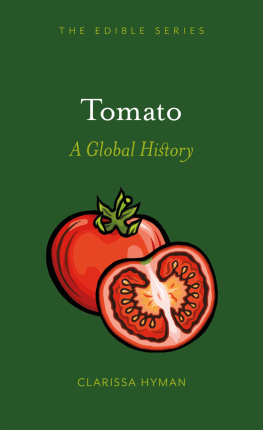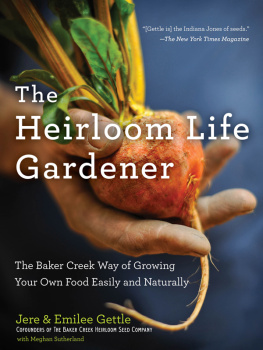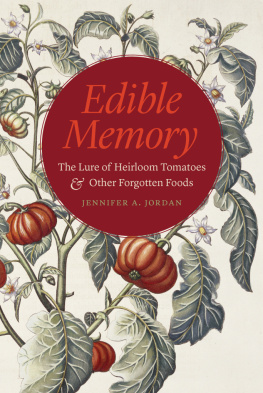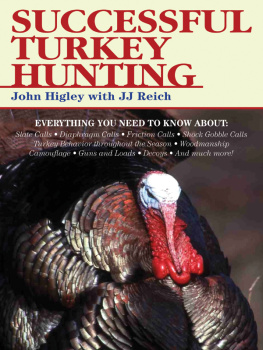Tim Stark - Heirloom : notes from an accidental tomato farmer
Here you can read online Tim Stark - Heirloom : notes from an accidental tomato farmer full text of the book (entire story) in english for free. Download pdf and epub, get meaning, cover and reviews about this ebook. City: New York, year: 2008, publisher: Broadway Books, genre: Non-fiction. Description of the work, (preface) as well as reviews are available. Best literature library LitArk.com created for fans of good reading and offers a wide selection of genres:
Romance novel
Science fiction
Adventure
Detective
Science
History
Home and family
Prose
Art
Politics
Computer
Non-fiction
Religion
Business
Children
Humor
Choose a favorite category and find really read worthwhile books. Enjoy immersion in the world of imagination, feel the emotions of the characters or learn something new for yourself, make an fascinating discovery.

- Book:Heirloom : notes from an accidental tomato farmer
- Author:
- Publisher:Broadway Books
- Genre:
- Year:2008
- City:New York
- Rating:5 / 5
- Favourites:Add to favourites
- Your mark:
- 100
- 1
- 2
- 3
- 4
- 5
Heirloom : notes from an accidental tomato farmer: summary, description and annotation
We offer to read an annotation, description, summary or preface (depends on what the author of the book "Heirloom : notes from an accidental tomato farmer" wrote himself). If you haven't found the necessary information about the book — write in the comments, we will try to find it.
Tim Stark: author's other books
Who wrote Heirloom : notes from an accidental tomato farmer? Find out the surname, the name of the author of the book and a list of all author's works by series.
Heirloom : notes from an accidental tomato farmer — read online for free the complete book (whole text) full work
Below is the text of the book, divided by pages. System saving the place of the last page read, allows you to conveniently read the book "Heirloom : notes from an accidental tomato farmer" online for free, without having to search again every time where you left off. Put a bookmark, and you can go to the page where you finished reading at any time.
Font size:
Interval:
Bookmark:

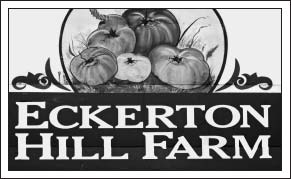
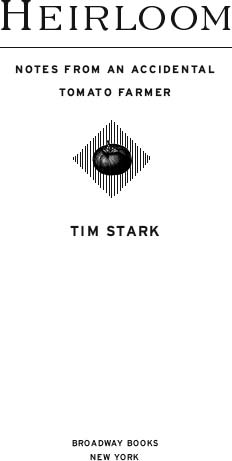
CONTENTS
FOR MY MOTHER AND FATHER
A FARM GROWS IN BROOKLYN
 AN UNSUSTAINABLE writers lifehunkered down at a desk on the top floor of a Brooklyn brownstoneproved to be the soil in which the farmer within me took root. Out in the street one wintry March evening, pacing and frothing over poverty, injustice, and those politely worded impersonal rejection letters quarterlies dispense the way banks hand out toasters, I came upon a trash bin loaded with basement scraps: water pipes, furring strips, two-by-fours studded with nails that could be straightened out and reused. From these scraps, I saw in a flash of insight, I could construct a seed germination rack. In the gardening catalogs, a deluxe seed starting kit, complete with full-spectrum light and soil heating mats, cost about eight hundred dollars. Which I didnt have.
AN UNSUSTAINABLE writers lifehunkered down at a desk on the top floor of a Brooklyn brownstoneproved to be the soil in which the farmer within me took root. Out in the street one wintry March evening, pacing and frothing over poverty, injustice, and those politely worded impersonal rejection letters quarterlies dispense the way banks hand out toasters, I came upon a trash bin loaded with basement scraps: water pipes, furring strips, two-by-fours studded with nails that could be straightened out and reused. From these scraps, I saw in a flash of insight, I could construct a seed germination rack. In the gardening catalogs, a deluxe seed starting kit, complete with full-spectrum light and soil heating mats, cost about eight hundred dollars. Which I didnt have.
What I did possessor so I fanciedwas a farmers resourcefulness. Four years earlier, I had started a vegetable garden on the land I had grown up on in Pennsylvania. Road trips in a battered Toyota pickup kept me and my landlord seasonally flush in tomatoes and pesto. I had never given serious thought, until this moment, to expanding into a truck patch. It was an idea so impractical it bordered on fantasy. Most everything I plantedpeas, lettuce, carrots, beans, sweet potatoes, beetsgot chewed down to nubs by deer and groundhogs. Whether these fur-bearing gourmands were susceptible to primitive superstitions about nightshades, I dont know, but come August, youd look at my garden and think the only thing Id planted was tomatoes. The vines strafed the basil and thyme, shaded the sun-loving peppers, and strangled the zucchini, which, only weeks earlier, armed with baseball-bat-sized fruit, had conquered the same ground. As for the tomatoes plumping up on those vines, some looked more like peaches, pears, lemons, or Cinderella pumpkins. There were purple, white, pink, and green orbs of musky softness whose rich, acidic juices colonized the canker sores that throbbed in my mouth until my addiction petered out in September. This jungle of sumptuous, mismatched love apples had its origins in winter days spent poring over the annual yearbook of the Seed Savers Exchange, a phonebooklike compilation of nonhybrid, heirloom seeds offered for a small fee by the gardeners, master and amateur, without whom the tomato would be red for eternity. Cherokee Purple, Green Zebra, Garden Peach, Plum Lemon, Radiator Charlies Mortgage Lifter. I could not help noticing how these tomatoes responded to me in ways that women, bosses, and literary editors never had.
It took five trips to drag my lumber and water pipes up three flights to my apartment. I already had soil heating mats, seeding trays, soil mix, and seed for some sixty tomato varieties. I bought cheap shop lights and hung them from the water pipes an inch above the seeded trays. A week later, my writers garret was home to three thousand fledgling tomato plants, tightly organized in labeled rows, stretching toward fluorescent bliss.
Alas, you cant file away three thousand tomato seedlings like another so-so draft. I had always replenished my writers war chest with freelance consulting gigs, so to support my tomatoes, I took on a consulting job that required frequent trips to Albany. When the seedlings outgrew the four trays in which they were crowded together, I spent a weekend potting them up into individual plugs, which meant I now had to accommodate forty plug trays. I bought more shop lightsenough to satisfy the photosynthetic needs of half my seedlingsand put the tomatoes on two twelve-hour shifts, half the trays soaking up the fluorescent rays while the other half slept. Since a sliver of light will keep a seedling awake until it keels over of insomnia, I went out to the street and hauled home four refrigerator-sized boxes so the slumbering trays could be placed in the pitch dark.
I was keeping farmers hours now, especially when I had to catch the 6:00 a.m. train to Albany. Up at four thirty in the morning to put my tomato seedlings through the Chinese fire drill, transferring the sleepers from the boxes to the fluorescent lights, bedding down the ones that had been up all night, watering and inspecting, readjusting my circulation fans, and checking on the chile peppers germinating on the heat mats. Another Chinese fire drill when I got home in the evening. My bedroom was a humid microcosm, bugs helicoptering here and there, the damp smell of tomato musk everywhere.
Once, during a meeting in Albany, I convinced myself I had forgotten to insert the thermometer into the soil of my chile peppers that morning. Horrific scenarios preyed on my imagination: with the thermometer exposed to air, the heat mats would grow hotter and hotter, the chile seedlings would fry, the refrigerator boxes would ignite. I left the meeting early and flew home to New York City, convinced I would have to rescue my seedlings from a burning brownstone.
As it turned out, the thermometer was lodged snugly in the soil, where it belonged.
City life agreed with my tomatoes. Unharried by the elements, they had their first brush with adversity on an April day when I carried them up to the roof. The real sun was no forty-watt bulb. The seedlings nearly wilted to death. For two weeks, I spent every free moment weaning them from the fluorescent lights, hauling them onto the roof, then back down when the wilting started. Adaptation to the sun brought with it a burst of growth: my seedlings needed larger containers. The rooftop was big enough to hold ninety trays, but I needed to construct cold frames to protect the seedlings from the unstable April weather. My landlord intervened when I found a trash bin full of windows for my cold frames. This was a landlord who, during lean months, had kindly accepted tomatoes and zucchini in lieu of rent. Concerned, and for good reason, that the windows of my cold frames would take flight in the wind, he evicted my tomatoes.
Two trips in my Toyota pickup brought all of the seedlings back to my boyhood home in Pennsylvania, to Eckerton, where I laid claim to a couple of acres of shaley ground and tracked down an old high-school classmate who managed to start up the Ford 8N tractor that had sat unused for fifteen years. The only labor I could afford was pro bono, so I convinced all of my friends who were doctors and lawyers that it would be fun to come out to the country for a weekend and help transplant two acres of seedlings with garden trowels. From there, my first season as a farmer unfolded as if the inverse of Murphys law was at work. Although I had no irrigation, the clouds delivered almost every week. When buyers at the local produce auction refused to bid on my gangly, multicolored misfits, Greenmarket in New York City offered me space. And so, back to that beautiful mosaic of a city they went, these upstarts with the quirky immigrant names: Black Krim, Extra Eros Zlatolaska, German Johnson, Aunt Rubys German Green, Zapotec Pleated, Rose de Berne.
The rest of that first season is a frenetic blur of pulling weeds and picking tomatoes and begging for peoplemy girlfriend, mother, father, friends, neighbors, anyoneto help me pick tomatoes.
Next pageFont size:
Interval:
Bookmark:
Similar books «Heirloom : notes from an accidental tomato farmer»
Look at similar books to Heirloom : notes from an accidental tomato farmer. We have selected literature similar in name and meaning in the hope of providing readers with more options to find new, interesting, not yet read works.
Discussion, reviews of the book Heirloom : notes from an accidental tomato farmer and just readers' own opinions. Leave your comments, write what you think about the work, its meaning or the main characters. Specify what exactly you liked and what you didn't like, and why you think so.

